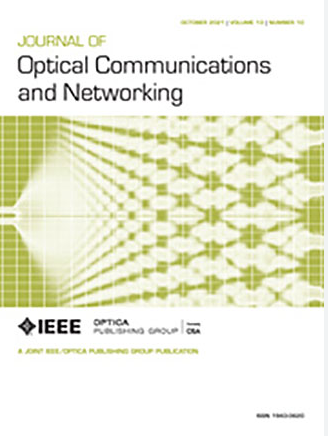多目标路由和频谱分配优化的量子计算方法
IF 4.3
2区 计算机科学
Q1 COMPUTER SCIENCE, HARDWARE & ARCHITECTURE
引用次数: 0
摘要
优化问题是包括电信在内的许多领域的基础问题,在这些领域中,有效的资源分配对于确保良好的网络性能和高可扩展性至关重要。在弹性光网络环境下,多目标路由和频谱分配(MO-RSA)问题是一个关键挑战,因为它涉及选择有效路径和分配频率时隙,同时满足连续性和连续性约束,并优化多个相互冲突的目标。本文提出了一种新颖的,据我们所知,基于量子的方法来解决MO-RSA问题。首先将MO-RSA问题表述为二次型无约束二进制优化(QUBO)问题,然后利用量子近似优化算法(QAOA)求解。我们的方法既可以最小化使用的链路总数(或任何非负的附加度量),又可以最大化光信噪比。对于我们的模拟,我们使用Qiskit框架和IBM的基于采样器的量子后端来实现和测试所提出的方法。我们的研究结果表明,通过将MO-RSA问题编码为QUBO模型并使用QAOA进行优化,我们获得了88%的近似比率和$O({n^2})$的计算复杂度,这比传统整数线性规划方法的指数复杂度有了显着提高。本文章由计算机程序翻译,如有差异,请以英文原文为准。
Quantum computing approach for multi-objective routing and spectrum assignment optimization
Optimization problems are fundamental in a wide range of fields, including telecommunications, where efficient resource allocation is critical to ensure good network performance and high scalability. In the context of elastic optical networks (EONs), the multi-objective routing and spectrum assignment (MO-RSA) problem represents a key challenge, as it involves selecting a valid path and assigning frequency slots while fulfilling continuity and contiguity constraints and optimizing multiple conflicting objectives. This paper presents a novel, to the best of our knowledge, quantum-based approach to solving the MO-RSA problem. We first formulate the MO-RSA problem as a quadratic unconstrained binary optimization (QUBO) problem and then solve it using the quantum approximate optimization algorithm (QAOA). Our method accounts for both minimizing the total number of used links (or any non-negative additive metric) and maximizing the optical signal-to-noise ratio. For our simulations, we employed the Qiskit framework and IBM’s sampler-based quantum backend to implement and test the proposed approach. Our results demonstrate that by encoding the MO-RSA problem into a QUBO model and optimizing it with QAOA, we achieved an approximation ratio of 88% and a computational complexity of $O({n^2})$ , which represents a significant improvement over the exponential complexity of traditional integer linear programming methods.
求助全文
通过发布文献求助,成功后即可免费获取论文全文。
去求助
来源期刊
CiteScore
9.40
自引率
16.00%
发文量
104
审稿时长
4 months
期刊介绍:
The scope of the Journal includes advances in the state-of-the-art of optical networking science, technology, and engineering. Both theoretical contributions (including new techniques, concepts, analyses, and economic studies) and practical contributions (including optical networking experiments, prototypes, and new applications) are encouraged. Subareas of interest include the architecture and design of optical networks, optical network survivability and security, software-defined optical networking, elastic optical networks, data and control plane advances, network management related innovation, and optical access networks. Enabling technologies and their applications are suitable topics only if the results are shown to directly impact optical networking beyond simple point-to-point networks.

 求助内容:
求助内容: 应助结果提醒方式:
应助结果提醒方式:


